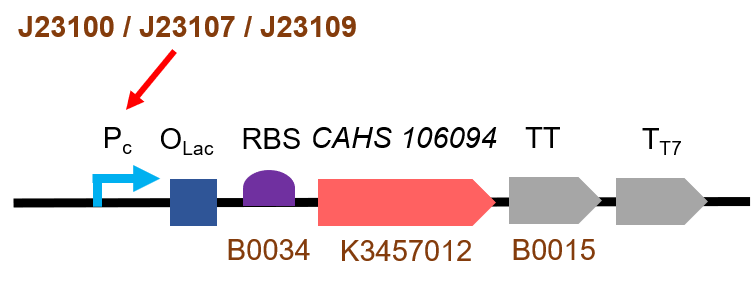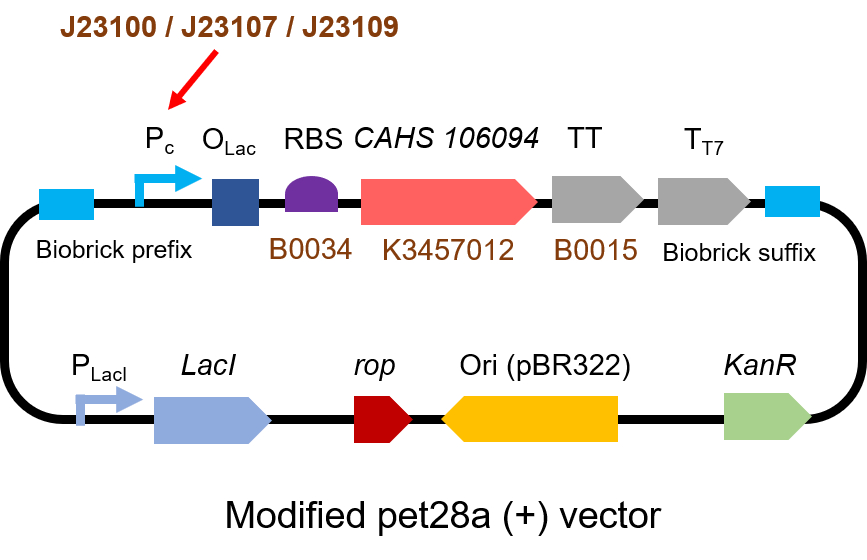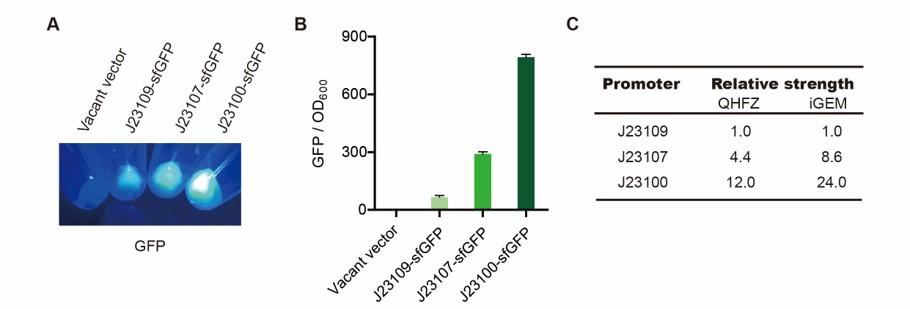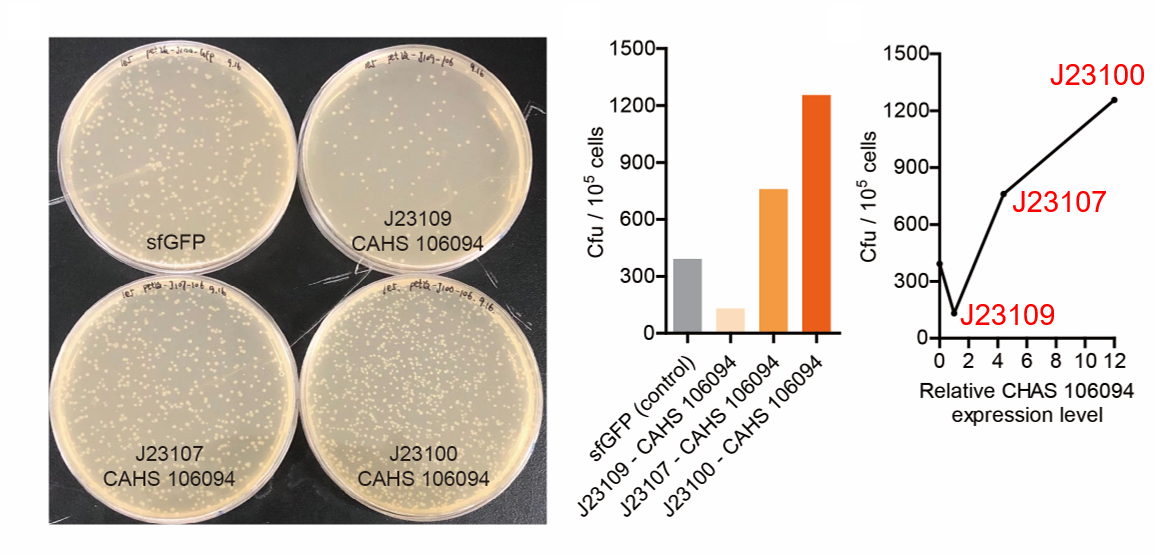Difference between revisions of "Part:BBa K3457049"
| (One intermediate revision by the same user not shown) | |||
| Line 3: | Line 3: | ||
<partinfo>BBa_K3457049 short</partinfo> | <partinfo>BBa_K3457049 short</partinfo> | ||
| − | a | + | <p> This biological part is the expression sequence of Cytosolic-abundant heat soluble protein 106094, also called CAHS 106094. It is a kind of Tardigrade intrinsically Disordered Protein (TDP). It is a heat soluble protein found from Tardigrade <i>Hypsibius dujardini</i> in 2017 <sup>[1]</sup>. Tardigrade, also called water bear, is a kind of tenacious organism. It can survive extreme environment, such as desiccation, freeze and vacuum. The super capacity of Tardigrade partially owes to TDPs. We want to test whether expressing this protein can help bacteria survive the freeze-drying process and then the resultant dry bacteria powder can be stored for a long time at room temperature. </p> |
| + | |||
| + | ===Contribution=== | ||
| + | <h2><b>Group: QHFZ-China iGEM 2020</b></h2> | ||
| + | <h3><b>Author: Yixian Yang</b></h3> | ||
| + | <h3><b>Design</b></h3> | ||
| + | [[File:T--QHFZ-China--J23-11.png|400px|thumb|left|Figure 1. The Schematic cartoon of the DNA construct of BBa_K3457049.]] | ||
| + | |||
| + | <p style="clear:left;"> This part was modified from [https://parts.igem.org/Part:BBa_K3457034 BBa_K3457034] T7-Olac-RBS-CAHS 106094 by Golden Gate technique. By changing the promoter, we could change the expression level of CAHS 106094. </p> | ||
| + | |||
| + | <h3><b>Documentation:</b></h3> | ||
| + | <h4><b>Introduction: </b></h4> | ||
| + | <p style="clear:left;"> This year, we tried to introduce a new biopreservation method. We used freeze-drying to make the engineered into dry powder. Then the powder can be stored at room temperature for a long time. This method can make the storage of bacteria get rid of ultra-low temperature freezer, so that it will promote the practical application of engineered bacteria out of laboratory. However, the stresses during freeze-drying and subsequent dry storage, including freeze, dry and vacuum, are lethal to bacteria. We use TDPs, including CAHS 106094, to help bacteria survive the situation. </p> | ||
| + | |||
| + | <h4><b>Protocol: </b></h4> | ||
| + | <p style="clear:left;"> To test the effect of CAHS 106094, we modified a frequently and widely used vector, pet28a+ and put this part into it (Fig. 2). Then we transformed the plasmid into <i>E. coli</i> BL21 strain. </p> | ||
| + | |||
| + | [[File:T--QHFZ-China--J2310-2.png|400px|thumb|left|Figure 2. The Schematic cartoon of the vector.]] | ||
| + | |||
| + | <p style="clear:left;"> Then we used the following protocols to verify its function (Fig. 3): </p> | ||
| + | |||
| + | [[File:T--QHFZ-China--freeze-dry protocol.jpg|400px|thumb|left|Figure 3. Experiment protocol.]] | ||
| + | |||
| + | <p style="clear:left;"> | ||
| + | 【Day 1】Induction culture<br> | ||
| + | (1) Pick clones which are in good condition and put them into 500 μL LB medium containing antibiotics. Shake them to grow at 37℃ for 5~7 hours until the bacteria solution becomes turbid. <br> | ||
| + | (2) Add 2 mM iPTG into 3 mL LB medium containing antibiotics. Add 3 μL of the bacteria solution mentioned in step 1 to dilute the bacteria by the ratio of 1:1000. Shake the solution to grow the bacteria at 37℃ overnight.<br> | ||
| + | 【Day 2】Freeze-dried<br> | ||
| + | (1) If fluorescence induced by the iPTG is detectable in the control group (GFP), continue conducting the experiment.<br> | ||
| + | (2) Use spectrophotometer to measure the OD<sub>600</sub> of the bacteria solution, OD<sub>600</sub> = 1 equals to 10<sup>9</sup> cells. If the OD<sub>600</sub> value is between 0.1 and 1, There is a linear relationship between OD<sub>600</sub> and bacterial density. Calculate the volume of bacterial solution for 10<sup>9</sup> cells by using the formula V = 100 / (OD<sub>600</sub> × Dilution ratio).<br> | ||
| + | (3) Take out a measured amount of 10<sup>9</sup> cells and centrifuge it at 8000 rpm for 3 min. Then pour out the supernatant.<br> | ||
| + | (4) Resuspend the bacteria in a 15 mL tube with pre-refrigerated 100 μL 3% glucose solution.<br> | ||
| + | (5) Take off the cover of the tube and put the bacteria into the cold trap. Open the compressor of the lyophilization machine and freeze the shake tube for 2 h at -70℃.<br> | ||
| + | (6) Put the caky bacteria solution into the drying chamber of the lyophilization machine. Open the vacuum pump to dry it in vacuum for 6h at 1 Pa vacuum degree.<br> | ||
| + | (7) Turn off the vacuum pump, place it at seal box filled with silica-gel desiccant a for 2 days at room temperature.<br> | ||
| + | 【Day 3】Room temperature storage<br> | ||
| + | 【Day 4】Detect the survival rate<br> | ||
| + | (1) Add 1 mL of sterile water to the tube, vortex for 15 s, placed it at room temperature for 10 min.<br> | ||
| + | (2) Adjust the density of the bacteria solution by gradient dilution, then spread 100 μL of the bacteria solution on the LB plate.<br> | ||
| + | (3) If the density above is not suitable, take 100μL of the solution and spread it on the LB plate after several gradient dilutions.<br> | ||
| + | (4) Culture the bacteria overnight at 37℃.<br> | ||
| + | 【Day 5】Cell Count<br> | ||
| + | (1) Take out the LB plate and take photos to record experimental results.<br> | ||
| + | (2) Use the automatic cell counting function of Image J to count the colone number on the LB plate, then compare the results between each group. | ||
| + | </p> | ||
| + | |||
| + | <h4><b>Results:</b></h4> | ||
| + | <p style="clear:left;"> First, by a reporter, sfGFP, we confirmed that the plasmid can normally expressed exogenous proteins in <i>E. coli</i> BL21 strain (Fig. 4).</p> | ||
| + | |||
| + | [[File:T--QHFZ-China--sfGFP.jpg|600px|thumb|left|Figure 4. Via a reporter, sfGFP, the expression function of the vector was verified.]] | ||
| + | |||
| + | <p style="clear:left;">Then, by freeze-drying and recover experiment, we found that compared with the control group (sfGFP), the bacteria expressing CAHS 106094 with J23107 had a better survival rate than the control group, but the survival rate was not as high as that of J23100 group (Fig. 5). This indecated that J23107 is a moderate promoter and can produce CAHS 106094 to protect bacteria, but not quite enough.</p> | ||
| + | |||
| + | [[File:T--QHFZ-China--J2310-3.png|600px|thumb|left|Figure 5. J23100- and J23107- CAHS 106094 protected bacteria during freeze-drying and subsequent dry storage, but J23109- CAHS 106094 did not.]] | ||
| + | |||
| + | <h4 style="clear:left;"><b>Reference: </b></h4> | ||
| + | <p style="clear:left;">[1] Boothby, T.C., Tapia, H., Brozena, A.H., Piszkiewicz, S., Smith, A.E., Giovannini, I., Rebecchi, L., Pielak, G.J., Koshland, D., and Goldstein, B. (2017). Tardigrades Use Intrinsically Disordered Proteins to Survive Desiccation. Mol Cell 65, 975-984 e975.</p><br> | ||
| + | |||
<!-- Add more about the biology of this part here | <!-- Add more about the biology of this part here | ||
Latest revision as of 01:43, 27 October 2020
J23107-Olac-RBS-CAHS 106094
This biological part is the expression sequence of Cytosolic-abundant heat soluble protein 106094, also called CAHS 106094. It is a kind of Tardigrade intrinsically Disordered Protein (TDP). It is a heat soluble protein found from Tardigrade Hypsibius dujardini in 2017 [1]. Tardigrade, also called water bear, is a kind of tenacious organism. It can survive extreme environment, such as desiccation, freeze and vacuum. The super capacity of Tardigrade partially owes to TDPs. We want to test whether expressing this protein can help bacteria survive the freeze-drying process and then the resultant dry bacteria powder can be stored for a long time at room temperature.
Contribution
Group: QHFZ-China iGEM 2020
Author: Yixian Yang
Design
This part was modified from BBa_K3457034 T7-Olac-RBS-CAHS 106094 by Golden Gate technique. By changing the promoter, we could change the expression level of CAHS 106094.
Documentation:
Introduction:
This year, we tried to introduce a new biopreservation method. We used freeze-drying to make the engineered into dry powder. Then the powder can be stored at room temperature for a long time. This method can make the storage of bacteria get rid of ultra-low temperature freezer, so that it will promote the practical application of engineered bacteria out of laboratory. However, the stresses during freeze-drying and subsequent dry storage, including freeze, dry and vacuum, are lethal to bacteria. We use TDPs, including CAHS 106094, to help bacteria survive the situation.
Protocol:
To test the effect of CAHS 106094, we modified a frequently and widely used vector, pet28a+ and put this part into it (Fig. 2). Then we transformed the plasmid into E. coli BL21 strain.
Then we used the following protocols to verify its function (Fig. 3):
【Day 1】Induction culture
(1) Pick clones which are in good condition and put them into 500 μL LB medium containing antibiotics. Shake them to grow at 37℃ for 5~7 hours until the bacteria solution becomes turbid.
(2) Add 2 mM iPTG into 3 mL LB medium containing antibiotics. Add 3 μL of the bacteria solution mentioned in step 1 to dilute the bacteria by the ratio of 1:1000. Shake the solution to grow the bacteria at 37℃ overnight.
【Day 2】Freeze-dried
(1) If fluorescence induced by the iPTG is detectable in the control group (GFP), continue conducting the experiment.
(2) Use spectrophotometer to measure the OD600 of the bacteria solution, OD600 = 1 equals to 109 cells. If the OD600 value is between 0.1 and 1, There is a linear relationship between OD600 and bacterial density. Calculate the volume of bacterial solution for 109 cells by using the formula V = 100 / (OD600 × Dilution ratio).
(3) Take out a measured amount of 109 cells and centrifuge it at 8000 rpm for 3 min. Then pour out the supernatant.
(4) Resuspend the bacteria in a 15 mL tube with pre-refrigerated 100 μL 3% glucose solution.
(5) Take off the cover of the tube and put the bacteria into the cold trap. Open the compressor of the lyophilization machine and freeze the shake tube for 2 h at -70℃.
(6) Put the caky bacteria solution into the drying chamber of the lyophilization machine. Open the vacuum pump to dry it in vacuum for 6h at 1 Pa vacuum degree.
(7) Turn off the vacuum pump, place it at seal box filled with silica-gel desiccant a for 2 days at room temperature.
【Day 3】Room temperature storage
【Day 4】Detect the survival rate
(1) Add 1 mL of sterile water to the tube, vortex for 15 s, placed it at room temperature for 10 min.
(2) Adjust the density of the bacteria solution by gradient dilution, then spread 100 μL of the bacteria solution on the LB plate.
(3) If the density above is not suitable, take 100μL of the solution and spread it on the LB plate after several gradient dilutions.
(4) Culture the bacteria overnight at 37℃.
【Day 5】Cell Count
(1) Take out the LB plate and take photos to record experimental results.
(2) Use the automatic cell counting function of Image J to count the colone number on the LB plate, then compare the results between each group.
Results:
First, by a reporter, sfGFP, we confirmed that the plasmid can normally expressed exogenous proteins in E. coli BL21 strain (Fig. 4).
Then, by freeze-drying and recover experiment, we found that compared with the control group (sfGFP), the bacteria expressing CAHS 106094 with J23107 had a better survival rate than the control group, but the survival rate was not as high as that of J23100 group (Fig. 5). This indecated that J23107 is a moderate promoter and can produce CAHS 106094 to protect bacteria, but not quite enough.
Reference:
[1] Boothby, T.C., Tapia, H., Brozena, A.H., Piszkiewicz, S., Smith, A.E., Giovannini, I., Rebecchi, L., Pielak, G.J., Koshland, D., and Goldstein, B. (2017). Tardigrades Use Intrinsically Disordered Proteins to Survive Desiccation. Mol Cell 65, 975-984 e975.
Sequence and Features
- 10COMPATIBLE WITH RFC[10]
- 12INCOMPATIBLE WITH RFC[12]Illegal NheI site found at 11
Illegal NheI site found at 34
Illegal NheI site found at 945 - 21COMPATIBLE WITH RFC[21]
- 23COMPATIBLE WITH RFC[23]
- 25COMPATIBLE WITH RFC[25]
- 1000COMPATIBLE WITH RFC[1000]





